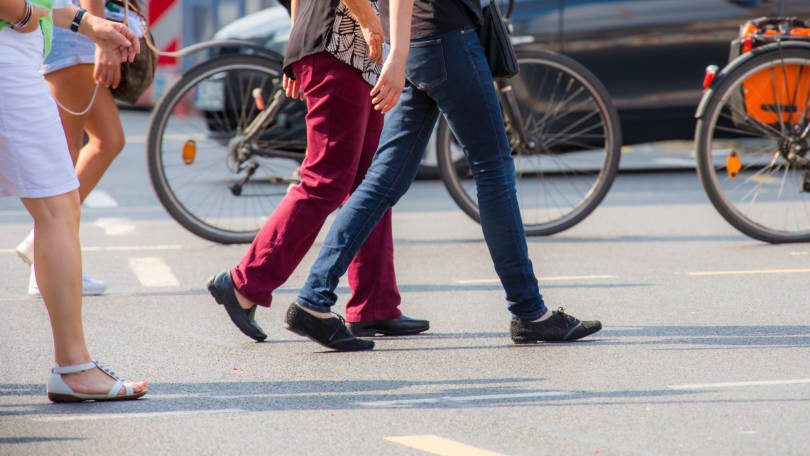
Source: Adobe Stock / Rainer Fuhrmann
Walking is the oldest and most popular form of movement. More than 80% of Germans like or even enjoy walking. Almost one third of the journeys is undertaken on foot. Walking is becoming ever more important to maintain everyday mobility, in particular among women, older people and children: these groups of the population walk most often. The share of walking is highest among over 80-year olds at 34%.
Walking is not only an independent type of traffic, but also a component of every other form of mobility, since it connects different modes of transport. In strengthening ecomobility, i.e. the combination of local public transport, cycling and pedestrian traffic, walking plays a central role that goes beyond just getting to the next public transport stop. Therefore, walking has to be a fundamental component of any kind of mobility strategy. In this context, walking, on the whole, has to become safer and more attractive.
The Federal Ministry for Digital and Transport has developed a Pedestrian Traffic Strategy in cooperation with experts and the federal states (see FURTHER INFORMATION). The objective is to improve the traffic conditions for pedestrians in Germany by strengthening the safety and attractiveness of pedestrian traffic at all federal levels as part of modern mobility.
Promoting pedestrian traffic
The Federal Ministry for Digital and Transport first started directly funding pedestrian traffic in 2022 and has continued to do so since then. The pedestrian traffic funding initiative was presented in 2023. It is intended to significantly enhance the safety and attractiveness of walking. Funding is provided both for investment and other measures for pedestrian traffic in Germany that contribute to promoting pedestrian traffic as the most climate-friendly transport mode, and one that is essential in intermodal transport chains.
The funding support is implemented by the project agency, the Federal Logistics and Mobility Office (BALM). The first funded measures were approved in 2024. For more information on the funded projects, please visit the website of the Federal Mobility Forum (in German only).
The 2024 Pedestrian Monitor study funded by the Ministry uses empirical evidence to verify the mood and behaviour of the population in Germany with regard to pedestrian mobility (e.g. frequency and purposes of use, etc.) for the first time. The data is broken down into adults (14 years and older) and children (6 to 13 years). The outcomes of the children’s survey are available on our website (in German only). The outcomes of the adults’ survey are available on our website (in German only).
The Federal Ministry for Digital and Transport is promoting pedestrian traffic at interfaces with other modes of transport, too. To promote the safety and attractiveness of pedestrian traffic, measures from different fields of actions are taken:
- As part of its National Cycling Plan (NCP), the Federal Ministry for Digital and Transport is promoting seven non-investment model projects at the walking-cycling interface with a total of more than 2.8 million euros. For more information please visit the Federal Mobility Forum.
- Seven more projects related to pedestrian traffic are being funded within the scope of the mFUND innovation programme. For more information, please visit the mFUND website.
- The Federal Highway Research Institute (BASt) is also conducting research on pedestrian traffic.
- With its Programme on Digitalization of Local Authority Transport Systems, the Federal Ministry for Digital and Transport is providing financial assistance to promote the digital transformation of urban mobility as well as health and climate action. The programme helps progress digital mobility solutions for cities and municipalities.
- The Research Programme on Automation and Connectivity in Road Transport is focused on transport and social policy issues related to automated driving.
- Within the framework of investment model projects, the Federal Ministry for Digital and Transport funds projects, e.g. the construction of foot and cycle path bridges, tunnels or crossing facilities, which also help improve pedestrian traffic.
One of the main priorities of the 2021-2030 Federal Government Road Safety Programme is safe walking. Safety is not only reflected in a dedicated field of action, pedestrian traffic is also included and seen as an essential element in the other thematic focus areas.
The specific measures of the Road Safety Programme are to focus on accident blackspots, since they have the highest potential for reducing the number of fatalities. In built-up areas, this affects mostly pedestrians, who, as unprotected road users, are at higher risk. Here, the focus should be mainly on measures to protect elderly road users.
As part of the Guidelines for the Funding of Measures to Improve Road Safety, the BMDV is also supporting various awareness-raising projects to increase the safety of pedestrians. Walking plays a key role, for instance, in the educational programmes for parents and senior citizens, also known as moderator programmes, of the German Road Safety Council and the German Accident Prevention Organization.
For more information on the 2021-2030 Road Safety Programme, please visit the German Road Safety Council website (see FURTHER INFORMATION).